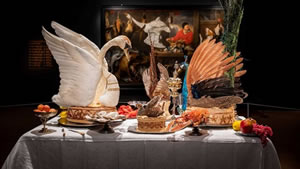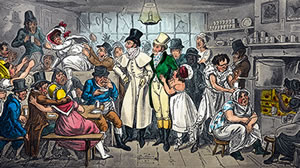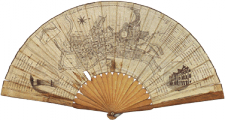The Georgian kitchen
’Food has always been a subject of art’
References
References about Cooking in Georgian Cities
- Syllabub
- Syllabub glasses are on the table in the Dining Room at Number 1
- Anchovies with parmesan cheese
- Salamanders: Shorter Oxford Dictionary offers ’a metal plate placed over food to brown it’
- Tea
- Tea in the Drawing Room and the Dining Room at Number 1
The Art of food. Making a meal of it.
Food has always been a subject of art. Increasingly, the reverse is the case too.
« TRA ARTE e cucina » - Between art and cuisine - is how the Uffizi Galleries describe their recently launched cooking show, « Uffizi on a plate »The Economist, May 1, 2021 (page 71)
The British Library

- Exhibiting Excess: Food through Art and History
- The British Library
Exploring two landmark exhibitions
[click on the picture to enlarge it]
Tasteful and polite, or riotous and pleasure-obsessed? Discover the Georgians as they really were, through the objects that tell the stories of their lives.
From beautifully furnished homes to raucous gambling dens, Georgians Revealed explores the revolution in everyday life that took place between 1714 and 1830. Cities and towns were transformed. Taking tea, reading magazines, gardening and shopping for leisure were commonplace, and conspicuous consumption became the pastime of the emerging middle classes.
Popular culture as we know it began, and with it the unstoppable rise of fashion and celebrity. Art galleries, museums and charities were founded. In this time of incredible innovation, ideas were endlessly debated in the new coffee houses and spread via the information highway that was mass print.
Drawing on the British Library’s uniquely rich and rare collections of illustrated books, newspapers, maps and advertisements, as well as loaned artworks and artefacts, Georgians Revealed brings to life the trials and triumphs of the ordinary people who transformed Britain forever.
To celebrate the exhibition, the Library and Cityscapes have created a Georgian garden installation on the Piazza designed by landscape architect and historian Todd Longstaffe-Gowan and funded by The Sackler Trust.

- Tom & Jerry at a Coffee Shop near the Olympic
- I.R. and G. Cruikshank.
’Tom & Jerry at a Coffee Shop near the Olympic’
Pierce Egan, Life in London. London, 1823 (British Library. 838.i.2)
[click on the picture to enlarge it]
This is an online event hosted on the British Library platform. Bookers will be sent a link in advance giving access and will be able to watch at any time for 48 hours after the start time.
Last year the Fitzwilliam Museum in Cambridge staged the brilliant Feast & Fast: The Art of Food in Europe (1500-1800), a multi-sensory exhibition showcasing multiple treasures and four spectacular historical reconstructions with food at their centre, including a Jacobean sugar banquet, a European feasting table and a Georgian confectioner’s workshop.
This year the Louvre-Lens is presenting The Tables of Power: A History of Prestigious Meals, spanning 5,000 years of the culinary arts. Archaeological objects, paintings, sculptures, tableware, metalwork and fabulous objets d’art recount the history of the meal and rich exchanges between civilisations.
Meet the lead curators for both exhibitions as they talk to consultant food historian Ivan Day about the journeys they took to bring these incredible food exhibitions to life.
Dr Victoria Avery has been Keeper of the Applied Arts Department at the Fitzwilliam Museum since 2010, prior to which she was Associate Professor in the History of Art Department, University of Warwick. Vicky has researched, lectured, and published widely on all aspects of the applied arts, especially on European sculpture, most recently editing a monograph on Michelangelo: Sculptor in Bronze. She has also co-curated several ambitious, interdisciplinary, research-led collaborative exhibitions at the Fitzwilliam, most recently Feast & Fast: The Art of Food in Europe (1500-1800), which was described as “remarkable and imaginative” by The Spectator, “highly entertaining” by the Telegraph, and as “a delight: erudite and joyful, sparking endless reflection” by the TLS.
Ivan Day is an independent food historian who has more than 40 years’ experience of accurately recreating period food using original historic equipment and methods. He is particularly interested in the evolution of table display and his work has been featured in numerous exhibitions in Britain, Europe, Canada and the US, including the Rothschild collection, the Bowes Museum, the Metropolitan, The Getty Research Institute and the Museum of Fine Arts, Houston. Ivan has worked with many curators of decorative arts in the interpretation of material culture linked to gastronomy. In 2012, he was the guest curator with Eike Schmidt of Supper with Shakespeare at the Minneapolis Institute of Art. In 2019 he worked with the Cambridge historians Victoria Avery and Melissa Calaresu on the groundbreaking exhibition Feast and Fast at the Fitzwilliam Museum.
Helène Bouillon is a Doctor of Egyptology, specialising in relations between Egypt and the Near East in antiquity. She has been heading the Louvre-Lens museum’s exhibitions department since December 2018 as Heritage Curator. She is also a member of the “Pharaonic Worlds” team at Sorbonne-University and teaches at the École du Louvre.
The Rise of consumerism
Georgian society in The British Library website
Article written by: Matthew White
Published on October 14, 2009
Food
Most towns enjoyed fresh produce as a result of expanding domestic trade. London – as a busy seaport – had regular access to seafood, and tonnes of fresh fish were landed at the city quaysides every day. Fresh fruit and vegetables also arrived from the nearby market gardens and orchards of the Home Counties, and elsewhere other towns held weekly agricultural and livestock markets.
Wining and dining remained fashionable among the wealthy, but for even the poorest members of society eating out was still possible. Most 18th-century towns had a range of cook-shops and taverns where meals could be bought cheaply, and drinks such as coffee and chocolate could be consumed. By mid-century there were perhaps 50,000 inns and taverns in Britain catering to all manner of customers. Coffee-houses in particular became great centres of sociability, where politics were discussed and business transactions conducted. Many banks and insurance houses, such as Lloyd’s of London, owe their origins to this 18th-century ‘coffee-house culture’. Household things.
As with food, over the course of this period the objects of everyday life that had once been too expensive for all but the wealthy gradually became accessible to the masses. Mass-produced, cheaper varieties of many household items were now within the grasp of the ordinary working man and woman, who began to enjoy the benefits of a ‘consumer revolution’.
Prosperity and expansion in manufacturing industries such as pottery and metalwares increased consumer choice dramatically. Where once labourers ate from metal platters with wooden implements, ordinary workers now dined on Wedgwood porcelain. Consumers came to demand an array of new household goods and furnishings: metal knives and forks, for example, as well as rugs, carpets, mirrors, cooking ranges, pots, pans, watches, clocks and a dizzying array of furniture. The age of mass consumption had arrived.
Explore the history of cookery books from the 18th century to the present day
Course dates: Saturday 25 – Sunday 26 May 10.30 – 17.00
Cookery books are an essential part of social history. By reading them we discover who was writing and cooking, and for whom. We can learn about writers’ kitchens, equipment, cooking methods, and how these changed over time. The availability and discovery of ingredients tells us a lot about trade, the growth of empire and the expansion of the known world.
During this weekend course you will encounter historical cookery books and learn about the earliest master chefs and their cooking methods. We’ll discover the 18th century books written by women for women, and discuss the boom of cookery books in the 20th century and today. Led by renowned food author, Jill Norman, this course will also provide some tips for aspiring food writers.

